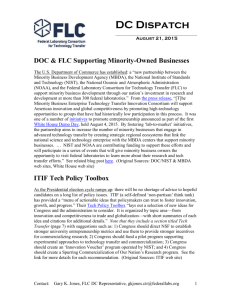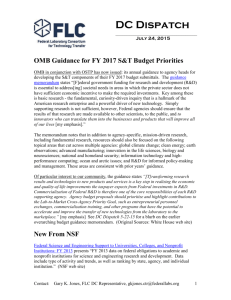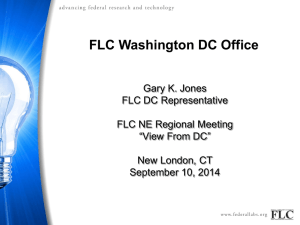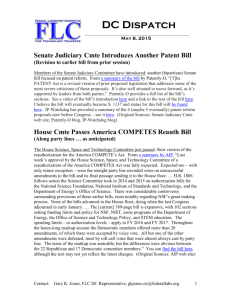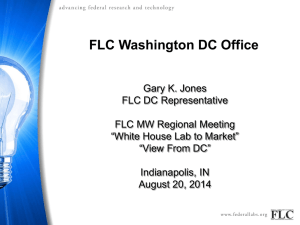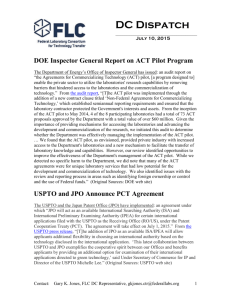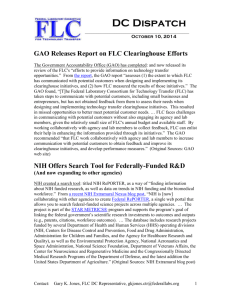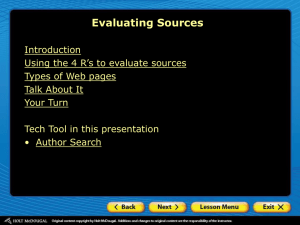November 7
advertisement
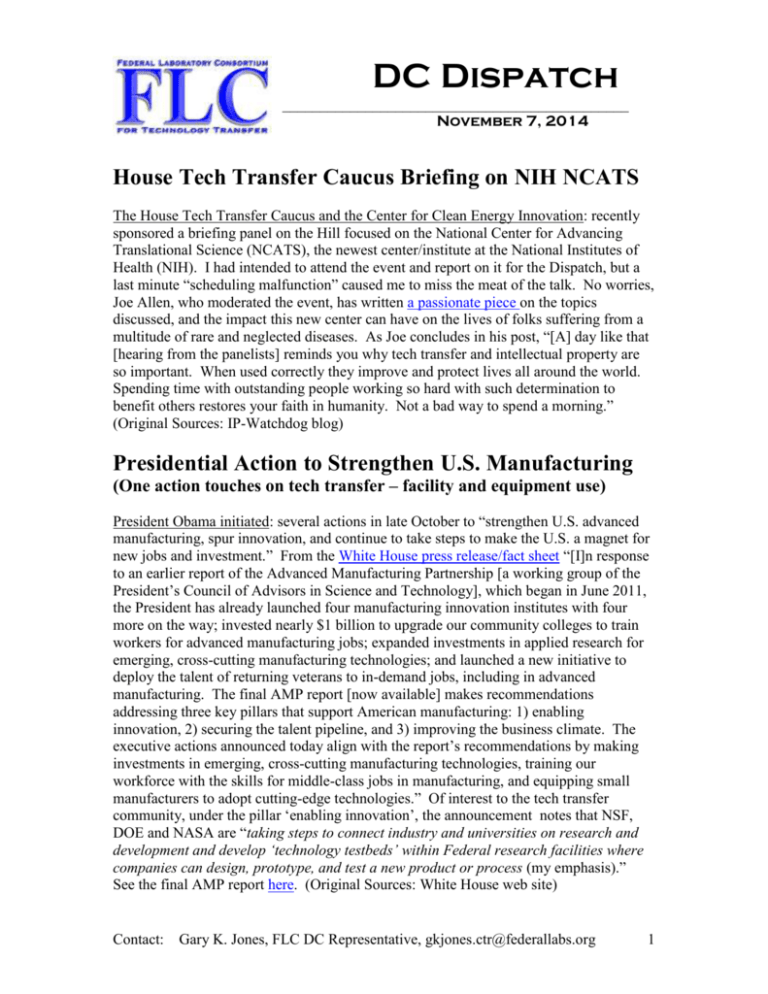
DC Dispatch ______________________________________________ November 7, 2014 House Tech Transfer Caucus Briefing on NIH NCATS The House Tech Transfer Caucus and the Center for Clean Energy Innovation: recently sponsored a briefing panel on the Hill focused on the National Center for Advancing Translational Science (NCATS), the newest center/institute at the National Institutes of Health (NIH). I had intended to attend the event and report on it for the Dispatch, but a last minute “scheduling malfunction” caused me to miss the meat of the talk. No worries, Joe Allen, who moderated the event, has written a passionate piece on the topics discussed, and the impact this new center can have on the lives of folks suffering from a multitude of rare and neglected diseases. As Joe concludes in his post, “[A] day like that [hearing from the panelists] reminds you why tech transfer and intellectual property are so important. When used correctly they improve and protect lives all around the world. Spending time with outstanding people working so hard with such determination to benefit others restores your faith in humanity. Not a bad way to spend a morning.” (Original Sources: IP-Watchdog blog) Presidential Action to Strengthen U.S. Manufacturing (One action touches on tech transfer – facility and equipment use) President Obama initiated: several actions in late October to “strengthen U.S. advanced manufacturing, spur innovation, and continue to take steps to make the U.S. a magnet for new jobs and investment.” From the White House press release/fact sheet “[I]n response to an earlier report of the Advanced Manufacturing Partnership [a working group of the President’s Council of Advisors in Science and Technology], which began in June 2011, the President has already launched four manufacturing innovation institutes with four more on the way; invested nearly $1 billion to upgrade our community colleges to train workers for advanced manufacturing jobs; expanded investments in applied research for emerging, cross-cutting manufacturing technologies; and launched a new initiative to deploy the talent of returning veterans to in-demand jobs, including in advanced manufacturing. The final AMP report [now available] makes recommendations addressing three key pillars that support American manufacturing: 1) enabling innovation, 2) securing the talent pipeline, and 3) improving the business climate. The executive actions announced today align with the report’s recommendations by making investments in emerging, cross-cutting manufacturing technologies, training our workforce with the skills for middle-class jobs in manufacturing, and equipping small manufacturers to adopt cutting-edge technologies.” Of interest to the tech transfer community, under the pillar ‘enabling innovation’, the announcement notes that NSF, DOE and NASA are “taking steps to connect industry and universities on research and development and develop ‘technology testbeds’ within Federal research facilities where companies can design, prototype, and test a new product or process (my emphasis).” See the final AMP report here. (Original Sources: White House web site) Contact: Gary K. Jones, FLC DC Representative, gkjones.ctr@federallabs.org 1 New from the American Academy of Arts & Sciences (Research and the American Dream … and tech transfer) The American Academy of Arts & Sciences has released: a report focused U.S. R&D and recommending “policy actions to help ensure the long-term sustainability of the U.S. science and engineering research enterprise.” From the report, titled Restoring the Foundation: The Vital Role of Research in Preserving the American Dream, “[T]he committee [established to prepare the report] based its work on three premises: first, that a strong U.S. economy is vital to the welfare and prosperity of the American people; second, that competitiveness in today’s accelerating high-tech, knowledge-based economy requires innovation and the rapid infusion of new knowledge and technologies; and third, that while applied research and applied development are both undeniably important, pathbreaking discoveries are most likely to come from basic research sustained over long periods of time, which is mainly funded by the federal government and carried out in the nation’s universities and national laboratories.” See the report for their detailed analysis and recommendations. The report has much to say about ‘tech transfer’, although its prime focus in this area is on federally-funded and university-created IP – and its commercialization (and policy prescriptions to enhance that effort) (my emphasis). It’s a thorough and worthwhile read on the U.S. R&D enterprise history and status – whether you agree with the recommendations or not. (Original Sources: Amacad web site) Spotlight on Member Initiatives (DOE Launches Lab Corps Program) The Department of Energy has just launched: a new lab program to “accelerate the commercialization of clean energy technologies”. From the DOE press release, “[T]oday [October 29], the Department of Energy launched a new $2.3 million pilot program to accelerate the transfer of innovative clean energy technologies from the DOE’s National Laboratories into the commercial marketplace. Lab-Corps aims to better train and empower national lab researchers to successfully transition their discoveries into highimpact, real world technologies in the private sector. … Lab-Corps, which builds on the National Science Foundation’s successful Innovation Corps (I-Corps™) model, is a specialized technology accelerator and training curriculum for the national laboratories that will enable lab-based teams to gain direct market feedback on their technologies and pursue the development of startup companies, industry partnerships, licensing agreements, and other business opportunities. Six national labs [NREL, ANL, INL, LBNL, LLNL, PNNL] have been selected to participate in the Lab-Corps pilot program. Over the next year, these labs will assemble, train, and support entrepreneurial teams to identify private sector opportunities for commercializing promising sustainable transportation, renewable power, and energy efficiency lab technologies.” See a White House blog post on the launch here. (Original Sources: DOE web site, White House web site) Contact: Gary K. Jones, FLC DC Representative, gkjones.ctr@federallabs.org 2 A Republican Senate and Patent Reform The recent election resulted: in a leadership change in the Senate – from Democrat to Republican. Patently-O assesses what this might mean for patent reform legislation in the new congress. From his blog, “[A]lthough the Washington DC politics of patent law is somewhat confusing, the divide on tort reform is much more clear and the pending patent reform legislation in Congress is largely tort reform (but with a focus on patents). The Republican led House of Representatives passed the Goodlatte Innovation Act in 2013 (H.R.3309), but Democrats in the Senate have stymied the Bill’s progress despite support from the White House. With Senate control now in Republican hands, I expect that a revised version of the Innovation Act will be able to pass through both houses of congress in 2015 and be signed by President Obama (his emphasis).” See the post for more details. (Original Sources: Patently-O blog) New From NSF Business R&D Performance in the United States Tops $300 Billon in 2012 states “[C]ompanies spent $302 billion on research and development performed in the United States during 2012, 2.8% more than the $294 billion spent during 2011. Funding from the companies’ own sources was $239 billion during 2011 and $247 billion during 2012, a 3.6% increase; funding from other sources was $55 billion in both years. …. During 2012, companies in manufacturing industries performed $208 billion (69%) of domestic R&D, defined as R&D performed in the 50 states and Washington, D.C. Most of the funding was from companies’ own funds (82%). Companies in nonmanufacturing industries performed $94 billion of domestic R&D (31% of total domestic R&D performance), 82% of which was paid for from companies’ own funds.” (Original Sources: NSF web site) Federal Science and Engineering Support to Universities, Colleges and Nonprofit Institutions: FYs 2010 and 2011 provides tabular data on “federal obligations to academic and nonprofit institutions by type of activity, year, and state, agency, and individual institution rankings. FY 2010 data breaks down each category of support into ARRA (American Recovery and Reinvestment Act of 2009) and non-ARRA components.” (Original Sources: NSF web site) Consulting Firm’s Perspective on Innovation in 2014 According to a survey conducted by the Boston Consulting Group: on innovation in 2014, “[T]hree-quarters of the 1,500 global senior innovation executives [surveyed] reported that innovation is among the top three priorities for their companies.” From their web site, “61 percent indicated that they are spending more on innovation this year than in 2013. While these numbers are largely consistent with those for 2013, important differences emerge when we look behind the averages at individual industries and countries.” See the link for more details, including a list of who they consider the top innovating firms in 2014. (Original Sources: BCG web site, Innovation Daily web site) Contact: Gary K. Jones, FLC DC Representative, gkjones.ctr@federallabs.org 3 R&D Management Conference Call for Papers (Italy in June anyone?) The R&D Management Conference 2015: will be held in Pisa, Italy, June 23-26, 2015. From the conference web site, “[T]he following list is only a starting point for the 2015 R&D Management conference programme, whose iconic symbol is the ‘connecting the dots’ exercise often enjoyed by children and professionals: …. - interactions between public and private research are being reconfigured and old traditional boundaries are becoming increasingly blurred; (my emphasis)…” See the call for papers here. (Original Sources: R&D Management conference web site) Patent Fun Facts (Computer patents on the rise; ‘Whereby’ clauses on the decline) Patently-O provides: some graphical” illustrations of two trends in U.S. patenting; the rise of computer-related patents and the demise of the ‘whereby’ clause in patenting. ---------------------------------------------------------------------------------------------- Note: The DC Dispatch is a periodic update of selected items of interest to the FLC and technology transfer community -- i.e., current legislation, trends, reports, policy and other developments potentially affecting technology transfer or related activities -- designed to keep the community informed of relevant issues on a timely basis. Information is gleaned directly from a variety of sources (newsletters, email alerts, web sites, direct participation at events from the FLC DC Representative’s office, etc.) -- with original sources, contacts and links provided. Contact: Gary K. Jones, FLC DC Representative, gkjones.ctr@federallabs.org 4
